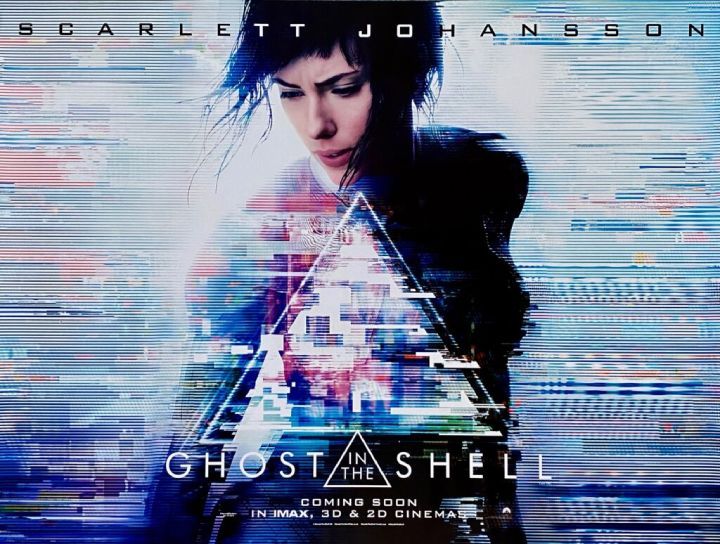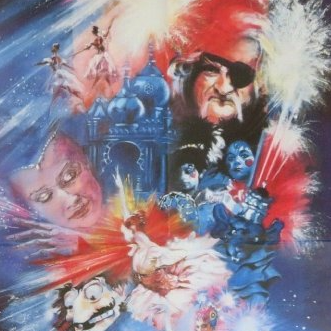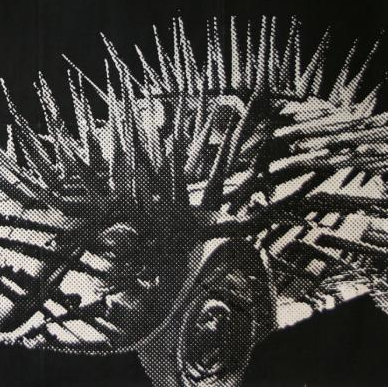Ghost in the Shell
To solve this crime, I have no choice but to become the GHOST IN THE SHELL.™

UK poster | Paramount Pictures
2017 — USA/China/India
An ARAD PRODUCTIONS/STEVEN PAUL production, presented by PARAMOUNT PICTURES, DREAMWORKS PICTURES and RELIANCE ENTERTAINMENT in association with SHANGHAI FILM GROUP, HUAHUA MEDIA and WEYING GALAXY
Cast: SCARLETT JOHANSSON, "BEAT" TAKESHI KITANO, MICHAEL CARMEN PITT, PILOU ASBÆK, CHIN HAN and JULIETTE BINOCHE
Director: RUPERT SANDERS
Producers: AVI ARAD, ARI ARAD and STEVEN PAUL
Executive Producers: MICHAEL COSTIGAN, JEFFREY SILVER, TETSU FUJIMURA, YOSHINOBU NOMA and MITSUHISA ISHIKAWA
Screenplay by: JAMIE MOSS and WILLIAM WHEELER and EHREN KRUGER
Original work by: SHIROW MASAMUNE
Editors: NEIL SMITH and BILLY RICH
Cinematographer: JESS HALL
Production design: JAN ROELFS
Costume design: KURT and BART
Music: CLINT MANSELL and LORNE BALFE
© Paramount Pictures / Storyteller Distribution Co.
If you’ve paid, like, any attention to anime over the past twenty-five years, you will presumably have heard of Ghost in the Shell. Mamoru Oshii’s 1995 film version is perhaps second only to Akira (1988) in terms of prominence and importance to Japanese animation on the global stage; it reportedly pares back the more light-hearted elements of the source material to focus more on the philosophical concerns of the plot. I haven’t read the original incarnation (even though it’s quite readily available), so I can’t really comment. I do know that the film renders the Major more serious both in her look and her temperament (and also that the manga originally had a fairly explicit and gratuitous lesbian sex scene that’s been excised from a lot of reprints, apparently at the creator’s request). Anyway, yes, it was reportedly a box office bomb upon release, but quickly gained a cult following, particularly abroad where it was pushed fairly hard by Manga Entertainment. They did have a vested interest in doing so; they actually invested quite a bit in the film’s production, enough that they even have a copyright claim on it.
So yeah, cyberpunk was the way forward for anime in the Anglosphere in the ‘90s. And so, in the grand style of capitalising on what was popular before, we have this live action Ghost in the Shell adaptation that eventually happened after hanging about longer than a turd from a fish’s arse. Don’t worry, there’s also that live action Akira that they’ve been threatening for a donkey’s age, to go with this and that Battle Angel Alita film (2019) that James Cameron spent ages trying to get to happen. Next up, a Bubblegum Crisis movie? It’s already been announced, kids! All your late ‘80s, early ‘90s cyberpunk anime favourites are a-comin’ back… in Pog Hollywood form!
Before you get too excited for the thrilling and entirely necessary live action version of Megazone 23 that is no doubt in our future, bear in mind that the development hell most of these projects have gotten stuck in are/were, as alluded to, pretty considerable. That Ghost in the Shell made it to screen less than a decade after being announced almost makes it impressive. And it didn’t even send previous versions into some kind of legal purgatory, James!
So then, it’s future year 20X6 or whatever and everyone’s all about those there cybernetic bodily augmentations. Transhumanism! Woo! And so on. We are introduced to Mira Killian (Scarlett Johansson), some kind of lady who’s a human brain inside a robotic body which is totes new and totes amazing, and the big boss man Cutter (Peter Ferdinando) wants to show off this swank new development by immediately throwing her into counter-terrorism operations. She’ll be cool with it; her family and her human body were totes killed by terrorists. Not to spoil anything, though the film does a pretty good job of that itself, but he is, of course, lying. You should be able to pick up that he’s an excessively shady guy pretty much as soon as he opens his mouth. One year later, our heroine has attained the rank of Major somehow in what feels like record time. Wouldn’t you know it, but terrorists are targeting the big shots at the big shady cybernetics company by hacking into robots and the augmented and having them do the dirty work. Can the Major crack the case before her creator (Juliette Binoche) is killed? She’s having hallucinations, apparently of the before times that she can’t seem to remember properly, and they’re only getting worse…
Those with familiarity with the old film may notice that there’s something quite different about that plot introduction. Actually, there are several things, but, you know, one thing at a time. The big thing is that the Major is now essentially Robocop. Her personal arc is about her discovering who she was when she was fully human, rather than her grappling with the janitor’s broom problem of how human she actually is; in a world where the majority of people have cybernetic implants where is the line drawn? Yeah, this isn’t particularly interested in that question, even though it’s pretty much the core question of the franchise. We could surmise that perhaps they were just wary of essentially doing Blade Runner, but that does raise the question of why they wouldn’t be wary of essentially doing Robocop. I guess to be fair, unlike either of those there’s never really a question of whether the Major is human here, it’s pretty much just treated as a given. No, she’s a human, just one created by a shady company with a lot of government influence. As such, her whole background, such as it is changes, and to tie this all in, the nature of the terrorism plot changes drastically as well, the original plot getting merged somewhat cackhandedly with the refugee one from the TV series (2002-2005) along with bits of plotlines from Innocence (2004) and the manga. Is this a bad thing? Well… yeah, probably. A lot of moral and ethical questions get tossed out the window along with the idea that the Major had any agency in becoming a cyborg übermensch. It also adds a layer of idiocy, as the evil corporation are apparently all about making cyborgs with ill-gotten parts (again, technically a spoiler, but surely you guessed) and then giving them the means to destroy them. It also, of course, gives an explanation for events that avoids directly blaming the government. No, no, it’s not the government killing and/or abducting refugees and dissidents and using them and their body parts for human experimentation, it’s just this one company and only at the behest of this one really dodgy guy at the top, like. Honest, guv. The whole premise feels at once a lot more convoluted and a lot more simplistic at the same time.
I guess I have to mention the big controversy; Scarlett Johansson as Major Motoko Kusanagi. Well, sort of. They had the foresight to change the name to make her not Japanese, except when they don’t. By now, you probably know the film’s twist as to the origin of the Major’s brain. Her performance is fine, I guess, though frankly she seems to be phoning it in, but it seems hard to believe there wasn’t a single Asian actress (even letting them off the hook on getting one of Japanese descent) who couldn’t have done the part justice. I suppose having the lead be both a woman and an ethnic minority would just be too much for a big budget film. A searing indictment of the industry, to be sure. Frankly if they’d just leaned into it, it’d still be a bit tone-deaf but it’d come across slightly better (or ‘not quite as bad’, I guess) than trying to have their cake and eat it like the final product does. I suppose it could’ve been worse; supposedly at one point in development they were looking into ways to Asian up a white actress using CG. Yeah.
As an aside, the casting of Beat Takeshi as the section chief feels like a sop as well. ‘See, we cast a well-known and well-respected Japanese actor in a prominent supporting role. It’s all good.’ He speaks entirely in Japanese. I suppose I can buy it as the cybernetics doing the translating as the explanation for why everyone’s able to understand each other, despite the dearth of other Japanese speakers,* but in practice it comes across as really weird and a bit distracting.
It’s kind of aggravating. Taken on its own merits, it’s not a terrible film, just a bit generic… aside from the race stuff, that’s like a whole weird minefield they decided to flop about in like a salmon having a temper tantrum. The production design is actually quite lovely, but the film as a whole suffers very much from comparison to other incarnations of Ghost in the Shell and has the problem of it seeming to desperately want to invite those comparisons, even recreating some scenes from the 1995 film shot for shot. We also run into the problem of the earlier film’s influence, with a bunch of the cool stuff that this film tries to emulate having already been done by various other films in the twenty-year interim, most infamously The Matrix (1999). The Wachowskis’ film perhaps inadvertently having a long tail in influencing the shooting of action scenes incidentally. Am I saying I blame them for the proliferation of the slow-motion fight scene in Hollywood movies? …Yeah, kinda. Of course, they weren’t the first to do it, and it had a point in The Matrix, but that film’s success certainly popularised the idea of slow-motion fight scenes, resulting in a ton of films that seem to think action scenes in slow-motion are inherently cool regardless of what’s happening. And this film is no exception. It’s all just so bland, devoid of philosophy or humour, turning a popular property into a spectacle at once po-faced and vapid. For what it’s worth, apparently the film was much better received in Japan, where Oshii’s film is supposedly perceived more as an oddity than a major thing; I’ve seen it said that the focus on action and spectacle make it more akin to the original comics where the philosophical concerns are more on the periphery, but that does seem to ignore that, at least from what I can tell, they have a lot more fun with the central conceit and setting. This film certainly wouldn’t be made worse by having a scene where she hacks a dude’s cyberbrain to make him punch himself out.
So, yeah. The live action Ghost in the Shell movie. It’s a thing to watch, maybe, if there’s nothing else to do. It seems unlikely that you’d regret the time spent, but it also seems unlikely that it’d leave all that much of an impression. The 1995 film, on the other hand, holds up pretty well. I recommend that while you wait for the Cyber Team in Akihabara live-action movie.
I’m just kidding. I doubt they’re going to do that one.
Prove me wrong, why don’t you?
* There are a handful of other Japanese people in the cast, though the only one with much screen time other than Takeshi is Kaori Momoi, who incidentally delivers her lines in English.
At time of writing, Ghost in the Shell is available to rent on Youtube and Amazon, amongst other services; additionally it's streaming on Amazon Prime. I recommend JustWatch for keeping up with where films are streaming (including this one!). Alternatively, physical copies are reportedly available for rent via Cinema Paradiso.
The film has a 12 rating, the BBFC citing "moderate violence [and] threat".



